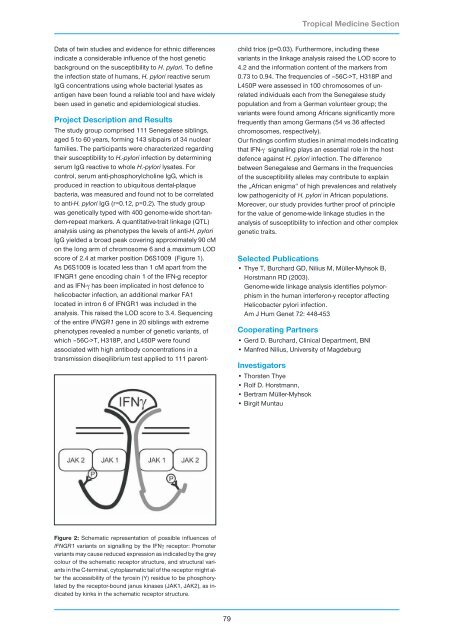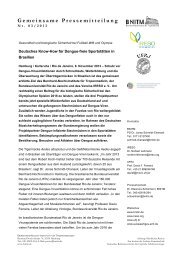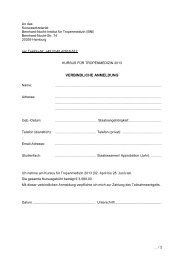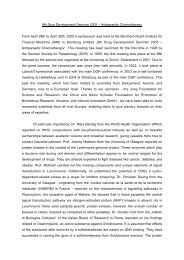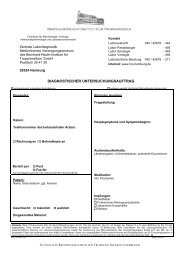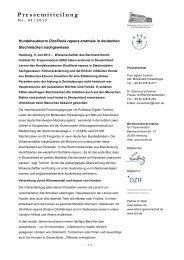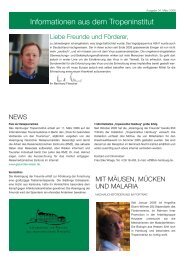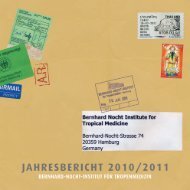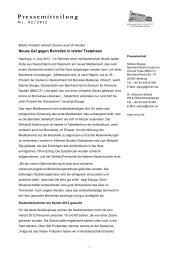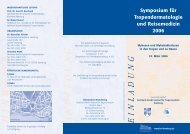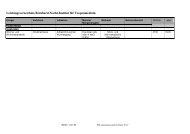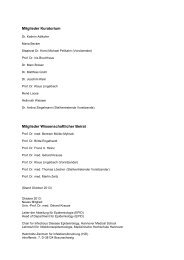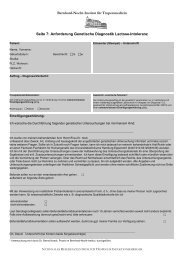Research Group Heussler (Malaria I) - Bernhard-Nocht-Institut für ...
Research Group Heussler (Malaria I) - Bernhard-Nocht-Institut für ...
Research Group Heussler (Malaria I) - Bernhard-Nocht-Institut für ...
Create successful ePaper yourself
Turn your PDF publications into a flip-book with our unique Google optimized e-Paper software.
Data of twin studies and evidence for ethnic differences<br />
indicate a considerable influence of the host genetic<br />
background on the susceptibility to H. pylori. To define<br />
the infection state of humans, H. pylori reactive serum<br />
IgG concentrations using whole bacterial lysates as<br />
antigen have been found a reliable tool and have widely<br />
been used in genetic and epidemiological studies.<br />
Project Description and Results<br />
The study group comprised 111 Senegalese siblings,<br />
aged 5 to 60 years, forming 143 sibpairs of 34 nuclear<br />
families. The participants were characterized regarding<br />
their susceptibility to H.-pylori infection by determining<br />
serum IgG reactive to whole H.-pylori lysates. For<br />
control, serum anti-phosphorylcholine IgG, which is<br />
produced in reaction to ubiquitous dental-plaque<br />
bacteria, was measured and found not to be correlated<br />
to anti-H. pylori IgG (r=0.12, p=0.2). The study group<br />
was genetically typed with 400 genome-wide short-tandem-repeat<br />
markers. A quantitative-trait linkage (QTL)<br />
analysis using as phenotypes the levels of anti-H. pylori<br />
IgG yielded a broad peak covering approximately 90 cM<br />
on the long arm of chromosome 6 and a maximum LOD<br />
score of 2.4 at marker position D6S1009 (Figure 1).<br />
As D6S1009 is located less than 1 cM apart from the<br />
IFNGR1 gene encoding chain 1 of the IFN-g receptor<br />
and as IFN-γ has been implicated in host defence to<br />
helicobacter infection, an additional marker FA1<br />
located in intron 6 of IFNGR1 was included in the<br />
analysis. This raised the LOD score to 3.4. Sequencing<br />
of the entire IFNGR1 gene in 20 siblings with extreme<br />
phenotypes revealed a number of genetic variants, of<br />
which –56C->T, H318P, and L450P were found<br />
associated with high antibody concentrations in a<br />
transmission diseqilibrium test applied to 111 parent-<br />
Figure 2: Schematic representation of possible influences of<br />
IFNGR1 variants on signalling by the IFNγ receptor: Promoter<br />
variants may cause reduced expression as indicated by the grey<br />
colour of the schematic receptor structure, and structural variants<br />
in the C-terminal, cytoplasmatic tail of the receptor might alter<br />
the accessibility of the tyrosin (Y) residue to be phosphorylated<br />
by the receptor-bound janus kinases (JAK1, JAK2), as indicated<br />
by kinks in the schematic receptor structure.<br />
79<br />
child trios (p=0.03). Furthermore, including these<br />
variants in the linkage analysis raised the LOD score to<br />
4.2 and the information content of the markers from<br />
0.73 to 0.94. The frequencies of –56C->T, H318P and<br />
L450P were assessed in 100 chromosomes of unrelated<br />
individuals each from the Senegalese study<br />
population and from a German volunteer group; the<br />
variants were found among Africans significantly more<br />
frequently than among Germans (54 vs 36 affected<br />
chromosomes, respectively).<br />
Our findings confirm studies in animal models indicating<br />
that IFN-γ signalling plays an essential role in the host<br />
defence against H. pylori infection. The difference<br />
between Senegalese and Germans in the frequencies<br />
of the susceptibility alleles may contribute to explain<br />
the „African enigma“ of high prevalences and relatively<br />
low pathogenicity of H. pylori in African populations.<br />
Moreover, our study provides further proof of principle<br />
for the value of genome-wide linkage studies in the<br />
analysis of susceptibility to infection and other complex<br />
genetic traits.<br />
Selected Publications<br />
• Thye T, Burchard GD, Nilius M, Müller-Myhsok B,<br />
Horstmann RD (2003).<br />
Genome-wide linkage analysis identifies polymorphism<br />
in the human interferon-y receptor affecting<br />
Helicobacter pylori infection.<br />
Am J Hum Genet 72: 448-453<br />
Cooperating Partners<br />
• Gerd D. Burchard, Clinical Department, BNI<br />
• Manfred Nilius, University of Magdeburg<br />
Investigators<br />
• Thorsten Thye<br />
• Rolf D. Horstmann,<br />
• Bertram Müller-Myhsok<br />
• Birgit Muntau<br />
Tropical Medicine Section


